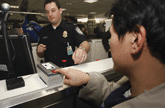The Homeland Security Department's Border and Transportation Security Directorate, in a way, is the Homeland Security Department.For starters, it's the largest of the department's five directorates, covering road, rail and air transportation as well as the gamut of immigration and border protections'it even includes the Animal and Plant Health Inspection Service.'It's really the main operational area [of DHS], other than maybe the Coast Guard and [the Federal Emergency Management Agency],' said Customs and Border Protection CIO Charlie Armstrong. 'The bulk of the clearance and enforcement activities are out of BTS.'The directorate's agencies account for about 60 percent of DHS employees and half the department's annual budget.Moreover, the directorate's IT systems account for 70 percent of DHS systems.BTS has big IT plans, including enterprise systems for overseeing visitor and immigration status, connecting security offices at more than 400 major airports, and a smart-card program covering millions of transportation workers. Those projects are in various stages of progress, but completion, in each case, is years away.The magnitude of those IT projects reflects the bureau's reach. BTS is responsible for securing the nation's borders and transportation systems, including 350 official ports of entry.Its agencies include Customs and Border Protection and the Transportation Security Administration, the Bureau of Immigration and Customs Enforcement, and the Bureau of Citizenship and Immigration Services.[IMGCAP(2)] The DHS directorates are organized by mission. On a chart, they look like silos. But their systems ultimately will be interoperable under the department's IT plan: They will transcend the mission silos.But because the agencies within BTS have missions that overlap and interconnect, IT leaders and managers have adopted both departmental and directorate-level views of the world, IT officials said.For instance, the department's goal of creating a single, integrated IT infrastructure is common to all the directorate's information executives and managers.'In terms of the infrastructure, we're trying to take more of a global or departmentwide view,' Armstrong said.But there are also fundamental, interconnecting business functions that require the directorate's agencies to share data to support the directorate's mission.'In terms of business issues within BTS, we're more focused on those as a directorate,' Armstrong said. 'There are some real cross-functional business lines that are inherent just within the directorate. So we've got some specific needs that we need to drive across the directorate.'Last year, for example, the investigative responsibilities for enforcing federal immigration and air-security laws were transferred to Immigration from Customs and Border Protection. But the agencies continue to share information.'A large portion of our agents are now in ICE but we're still sharing IT support for networks, infrastructure and applications, so there's a lot of interaction going on there,' said Rod MacDonald, director of software development for CBP.The department's enterprise architecture work has helped give the directorate's IT staff a bird's-eye view of BTS's systems and see who needs access to what.[IMGCAP(3)] 'The EA has helped us understand who's using what kinds of technologies and what kinds of information systems are available,' Armstrong said. 'In some cases, we've been able to help some of our business users get access to information they wouldn't have had normally.'At the center of the directorate's IT efforts is the United States Visitor and Immigrant Status Indictor Technology program, which DHS considers the cornerstone of its goal to improve border management at U.S. ports of entry.'U.S. Visit is a groundbreaker,' said Scott Hastings, CIO of the program. 'It's really the first enterprise solution in the department. It's an application that crosses mission areas and therefore needs to be managed in a consolidated manner as a departmental resource.'The department launched the first phase of the system last December, when it began scanning fingerprints and taking digital photos of foreign travelers at 115 airports and 14 seaports.Last month, the department awarded Accenture LLP of Reston, Va., a systems integration contract to carry U.S. Visit through its next phases.DHS built the first phase by integrating legacy systems, including the Ident automated fingerprint identification system, the Interagency Border Information System, and the Enforce booking and holding system for apprehensions.The system's next milestone occurs at the end of this year, when it faces a congressionally mandated deadline for rollout at the nation's 50 busiest land ports of entry. It's a deadline the General Accounting Office has called challenging.'We are on target to meet the Dec. 31 requirement,' Hastings said.From the industry viewpoint, U.S. Visit seems to be making progress.'I think industry is fairly comfortable that it's on a reasonable track,' said a source close to the IT industry. 'After all the years of the [defunct] Immigration and Naturalization Service's entry-exit system as a floundering program, here you have one that seems to be making progress.'Hastings said making the transition this year to a major systems integration contract will be a thorny task.'It's always a challenge to get [the prime contractor] up to speed and deal with all the transition issues that accrue after the award of a major integration contract,' he said.And Congress recently increased the degree of difficulty when the House Appropriations Committee passed an amendment that would block the U.S. Visit contract award to Accenture.[IMGCAP(4)] The full benefits of other BTS projects also are years away from realization. These include TSA's Red, White and Blue Plan for connecting offices at airports and the Transportation Worker Identification Credential, which is intended eventually to issue smart cards to millions of transportation workers for physical and network entry.Under the plan, prime contractor Unisys Corp. is rolling out an IT infrastructure in three phases to connect security offices at 429 major commercial U.S. airports.About 200 locations have been connected as part of the white, or second, phase, said former TSA CIO Patrick Schambach, who left government work at the end of last month. The white phase, in its first year, involves providing LAN and WAN connectivity for each location.Schambach said he was hopeful that the white phase can be wrapped up in two years, as planned.One obstacle has been getting local airports wired.'These airports are not easy to get into,' he said. 'We know how to wire up commercial buildings; the problem is that airports are not normal commercial buildings. Their architectures are different. Even the local construction codes vary.'Officials plan to add mission-critical applications in the project's blue, or final, phase.Meanwhile, TSA's credentialing program office is now looking for a prime contractor to take the TWIC program through its next increment, program officials said.During a technical evaluation phase completed last October, officials decided to use cards with computer chips that can store biometric identifiers.Officials last month released a request for proposals through the General Services Administration's Smart Access Common ID contract to test the program's business processes, including enrollment and background checks, and issue cards, said Lolie Kull, program manager for TWIC. At press time, a contract award had not been announced.Once awarded, officials hope to launch a prototype program next month, Kull said.When and if the system is fully implemented, as many as six million smart cards could be issued to transportation workers.'We won't make the final decision on full implementation until we evaluate the business processes we'll be working with during the prototype,' Kull said.In a report last December, GAO cited cost as a major impediment to the TWIC program. But Kull said TWIC is designed to eventually be paid for by fees.'Once fully implemented, the cost of the program would be borne by the users,' Kull said.Justin Oberman, director of the credentialing program office, said the fee would cover background checks as well as the cost of the card.TWIC currently is funded at $50 million and the Bush administration has requested another $50 million for 2005, Oberman said.'We're doing some analysis right now to determine whether that's sufficient,' he said. 'That's going to depend in large part on the outcome of the prototype.'Certainly, there are major challenges ahead for the agencies in the directorate. But they won't be technical, CBP's Armstrong said.'We've got a lot of transformation that needs to take place in the next couple of years,' Armstrong said. 'But it will be more of a business challenge. The technology is going to get easier.'XXXSPLITXXX- Border and Transportation Security Directorate U.S. Visit automates the process of verifying the identity of foreign nationals at U.S. ports of entry. Officials use digital systems to scan fingerprints and take photographs of visitors traveling on visas. The first iteration was built by integrating legacy systems such as the Ident automated fingerprint identification system. The first phase of the system was rolled out last December at 115 airports and 14 seaports across the country. Fiscal 2004 appropriation was $328 million. Proposed funding level for fiscal 2005 is $340 million, a 4 percent increase. Accenture LLP of Reston, Va. Under congressional mandate, U.S Visit must be expanded to the 50 busiest land ports of entry by the end of this year and implemented at all ports by Dec. 31, 2005. The project has many inherent risks, the General Accounting Office said in a recent report. 'It is to perform a critical, multifacted mission, its scope is large and complex, it must meet a demanding implementation schedule and its potential cost is enormous,' GAO said. Citing DHS estimates, GAO reported that the program could cost $7.2 billion through fiscal 2014. Also, Congress is considering legislation that would overturn the contract award to Accenture.XXXSPLITXXX- Transportation Security Administration TSA is implementing an IT infrastructure in three phases to security offices at 429 commercial airports in the U.S. The red, or first, phase deployed servers, desktop and notebook PCs, and other equipment at the airports and was completed last year. The white phase, in progress, is adding connectivity via LANs within the airports and WAN links from the airports to TSA headquarters. The blue phase, yet to come, would install advanced technologies such as electronic surveillance and biometric systems at airports.Funding: Unavailable Unisys Corp. is building the infrastructure under the IT Managed Services Contract. Officials expect the white phase to take about another 18 months to wrap up. About 200 locations have been wired to date. The 'physical realities' of wiring airport locations and nettlesome local construction codes have slowed progress on the current phase of the project, TSA says.XXXSPLITXXX- Transportation Security Administration The aim of TWIC is to provide physical and logical access to millions of U.S. transportation workers via smart cards supported by biometric identifiers. Officials in TSA's credentialing program office finished a technical evaluation phase last year. As this issue went to press, officials were evaluating proposals to award a prime contract through the General Services Administration's Smart Access Common ID Contract. Currently funded at $50 million. The administration has requested $50 million for fiscal 2005. When complete, the program will be self-supporting, funded entirely by user fees, TWIC officials say. TWIC's business processes will be assessed in the next phase, which officials expect to get under way in July. Officials say a final decision on the feasibility of full implementation will be made after they evaluate TWIC business processes. GAO has identified high cost as a major hurdle to implementation.
U.S. Visit uses biometrics to verify the identity of foreign nationals at some points of entry by photographing them and scanning their fingerprints. Congressional mandate requires full implementation at all U.S. air- and seaports by the end of 2005.
Olivier Douliery
'We've got a lot of transformation that needs to take place in the next couple of years. But it will be more of a business challenge. The technology is going to get easier.'
' Charlie Armstrong, Customs and Border Protection CIO
J. Adam Fenster
Former CIO Patrick Schambach said TSA security offices at 200 commercial airports have been connected as part of the Red, White and Blue Plan.
Henrik G. de Gyor
'U.S. Visit is a groundbreaker. It's really the first enterprise solution in the department.'
'Scott Hastings, Program CIO
Henrik G. de Gyor
TSA's Red, White and Blue Plan proposes an IT infrastructure for air- and seaport security to be introduced in three parts, beginning with deployment of conventional computer hardware and eventually including biometric identification systems.











